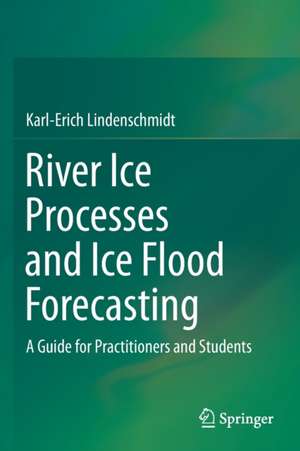River Ice Processes and Ice Flood Forecasting: A Guide for Practitioners and Students
Autor Karl-Erich Lindenschmidten Limba Engleză Paperback – 5 oct 2020
| Toate formatele și edițiile | Preț | Express |
|---|---|---|
| Paperback (1) | 486.98 lei 3-5 săpt. | |
| Springer International Publishing – 5 oct 2020 | 486.98 lei 3-5 săpt. | |
| Hardback (1) | 482.62 lei 38-44 zile | |
| Springer International Publishing – 2 feb 2024 | 482.62 lei 38-44 zile |
Preț: 486.98 lei
Nou
Puncte Express: 730
Preț estimativ în valută:
93.20€ • 96.94$ • 76.94£
93.20€ • 96.94$ • 76.94£
Carte disponibilă
Livrare economică 24 martie-07 aprilie
Preluare comenzi: 021 569.72.76
Specificații
ISBN-13: 9783030286811
ISBN-10: 3030286819
Pagini: 267
Ilustrații: XIV, 267 p. 269 illus., 216 illus. in color.
Dimensiuni: 155 x 235 mm
Greutate: 0.4 kg
Ediția:1st ed. 2020
Editura: Springer International Publishing
Colecția Springer
Locul publicării:Cham, Switzerland
ISBN-10: 3030286819
Pagini: 267
Ilustrații: XIV, 267 p. 269 illus., 216 illus. in color.
Dimensiuni: 155 x 235 mm
Greutate: 0.4 kg
Ediția:1st ed. 2020
Editura: Springer International Publishing
Colecția Springer
Locul publicării:Cham, Switzerland
Cuprins
Chapter 1: Introduction◦ Red River◦ Dauphin RiverChapter 2: Ice physics & mechanics◦ physical properties of ice◦ creep and fracture of ice
Chapter 3: Freeze-up processes◦ Freeze-up processes◦ Impacts of flow regulation on river freeze-up
Chapter 4: Exercise - river cooling and ice cover extent◦ 0 °C isotherm◦ ice cover length
Chapter 5: Monitoring ice covers◦ tracking ice cover characteristics◦ ice strength and ice maps
Chapter 6: Exercise - characterising river ice types◦ processing remote sensing data◦ extracting ice types from satellite imagery
Chapter 7: Breakup & ice jam processes◦ tracking breakup along Peace and Slave rivers◦ impacts of flow regulation on ice cover breakup
Chapter 8: Exercise - equilibrium ice jams & javes◦ equilibrium ice jam staging◦ surge velocity and staging of ice jam release waves
Chapter 9: Ice jam flood risk assessment and mapping◦ flood risk= hazard ラ vulnerability◦ ice jam flood risk assessment and mapping of the town of Peace River
Chapter 3: Freeze-up processes◦ Freeze-up processes◦ Impacts of flow regulation on river freeze-up
Chapter 4: Exercise - river cooling and ice cover extent◦ 0 °C isotherm◦ ice cover length
Chapter 5: Monitoring ice covers◦ tracking ice cover characteristics◦ ice strength and ice maps
Chapter 6: Exercise - characterising river ice types◦ processing remote sensing data◦ extracting ice types from satellite imagery
Chapter 7: Breakup & ice jam processes◦ tracking breakup along Peace and Slave rivers◦ impacts of flow regulation on ice cover breakup
Chapter 8: Exercise - equilibrium ice jams & javes◦ equilibrium ice jam staging◦ surge velocity and staging of ice jam release waves
Chapter 9: Ice jam flood risk assessment and mapping◦ flood risk= hazard ラ vulnerability◦ ice jam flood risk assessment and mapping of the town of Peace River
Notă biografică
Karl-Erich Lindenschmidt is an associate professor at the University of Saskatchewan. He holds a Bachelor of Science in Mechanical Engineering from the University of Manitoba, a Master of Applied Science in Mechanical Engineering from the University of Toronto, a PhD in Environmental Engineering from the Technical University of Berlin and a Habilitation degree from the Technical University of Cottbus, Germany. Before his appointment at the University of Saskatchewan, Karl was with Manitoba Water Stewardship as a hydrologic modelling research engineer where one of his research topics involved monitoring and modelling river ice processes along the Red, Assiniboine and Dauphin Rivers.
His knowledge on river ice processes aided Red River Floodway operations, the Ice Jam Mitigation Program along the lower Red River and flood risk management of the Lake St. Martin/Dauphin River system. He has also extended his portfolio of river ice work and research to include the Slave River in the Northwest Territories, the Peace and Athabasca rivers in Alberta, the South Saskatchewan and Qu’Appelle rivers in Saskatchewan and the Churchill and Exploits rivers in Newfoundland/Labrador.
His knowledge on river ice processes aided Red River Floodway operations, the Ice Jam Mitigation Program along the lower Red River and flood risk management of the Lake St. Martin/Dauphin River system. He has also extended his portfolio of river ice work and research to include the Slave River in the Northwest Territories, the Peace and Athabasca rivers in Alberta, the South Saskatchewan and Qu’Appelle rivers in Saskatchewan and the Churchill and Exploits rivers in Newfoundland/Labrador.
Textul de pe ultima copertă
This book exposes practitioners and students to the theory and application of river and lake ice processes to gain a better understanding of these processes for modelling and forecasting. It focuses on the following processes of the surface water ice: freeze-up, ice cover thickening, ice cover breakup and ice jamming. The reader will receive a fundamental understanding of the physical processes of each component and how they are applied in monitoring and modelling ice covers during the winter season and forecasting ice floods. Exercises accompany each component to reinforce the theoretical principles learned. These exercises will also expose the reader to different tools to process data, such a space-borne remote sensing imagery for ice cover classification. A thread supporting numerical modelling of river ice and lake ice processes runs through the book.
Caracteristici
Provides students and practitioners with an understanding of theory and application of river ice processes Includes exercises designed for students to become familiar with available tools such as those used to process remote sensing data Prepares the reader with fundamental knowledge to be applied in monitoring, modelling and forecasting ice covers and floods
